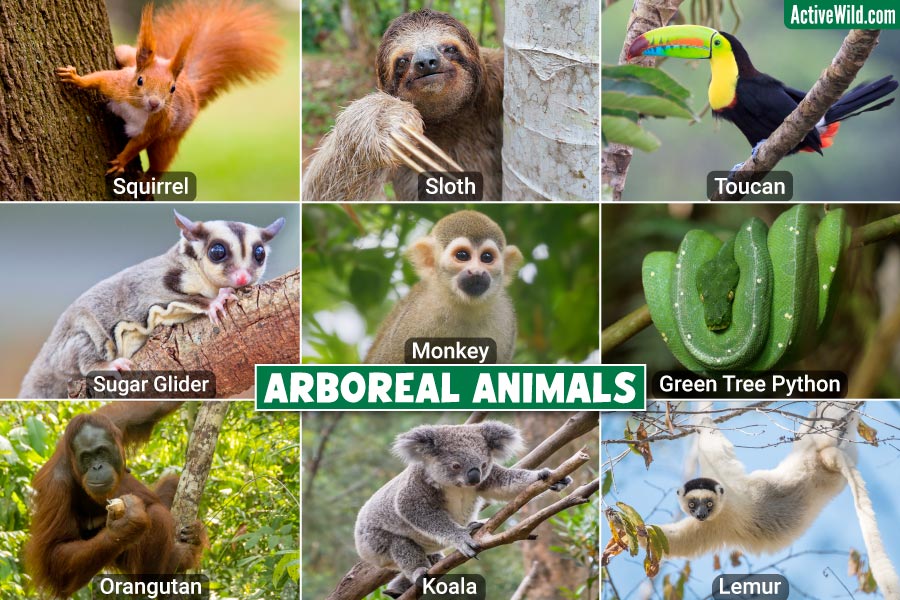Arboreal animals are animals that spend most of their lives in trees. Examples of arboreal animals include amphibians such as tree frogs and flying frogs; birds such as toucans and woodpeckers; insects such as tree hoppers and weaver ants, mammals such as monkeys, gibbons, lemurs, squirrels and sloths; and reptiles such as chameleons and geckos.
On this page is a list of arboreal animals from around the world, with information on the various adaptations found in animals that live in trees, and the advantages of an arboreal lifestyle
What Is An Arboreal Animal?
An arboreal animal is one that has adapted to living in the trees for most or all of its life. This tree-dwelling lifestyle is common in various species across different classes of animals, including mammals, birds, insects, and reptiles.
Living in trees provides arboreal animals with a rich source of food like leaves, fruits, nuts, and other smaller organisms, along with protection from ground-based predators.
Additionally, the high vantage points of trees are advantageous for monitoring threats and for some species, the leafy branches offer a perfect platform for gliding or flying from tree to tree.
The arboreal habitat influences many aspects of these animals' behavior, diet, and even social structures, making them integral components of their ecosystems.
Arboreal Animals Adaptations
Arboreal animals exhibit a variety of physical and behavioral adaptations that enable them to navigate, forage, and evade predators in the complex three-dimensional environment of treetops.
Many of these adaptations allow improved arboreal locomotion. Arboreal locomotion is a term used to describe the various means by which arboreal animals move in the trees. This can include climbing, leaping, gliding and swinging.
Adaptations of arboreal animals include:
- Prehensile Limbs: Many arboreal mammals, like monkeys and some possums, have prehensile tails or limbs that can grasp branches firmly, aiding in climbing and stability.
- Gripping Pads: Tree frogs have suction pads on their feet that help them cling to leaves and branches, even when upside down. Geckos have pads on their feet that allow them to grip onto smooth surfaces. Arboreal primates have hairless fingertips to increase friction.
- Claws and Nails: Sharp claws in animals like squirrels, some bears, and various arboreal lizards help them grip bark and climb efficiently. Some primates have flattened nails instead of claws, allowing for a more precise grip on branches.
- Flexible Joints: Arboreal animals often have highly flexible shoulder and hip joints, allowing for a wide range of motion to navigate through foliage and branches.
- Camouflage: Insects, reptiles, and other small arboreal animals often have coloration and patterns that blend with the trees, making them less visible to predators.
- Balance: Many arboreal animals, like the margay cat, have a low center of gravity and long tails that aid in balance while moving through the treetops.
- Gliding and Flying: Some species, like flying squirrels, sugar gliders, and colugos, have developed membranes between their limbs that allow them to glide from tree to tree, while birds and bats are capable of powered flight.
- Lightweight Body: A lighter body mass is beneficial for many arboreal species to reduce the risk of falling and to make it easier to move among less sturdy branches.
- Strong Musculature: Animals such as gibbons have strong muscles in their arms and shoulders that enable brachiation, allowing them to swing from branch to branch with ease.
- Acute Sensory Perception: Keen vision, touch, and hearing help arboreal animals to navigate the complex tree environment, locate food, and detect predators or rivals.
Below, you'll find information on well-known arboreal animal groups. Further down the page you'll find a list of arboreal species with pictures and facts on each.
Examples Of Arboreal Animals With Pictures & Facts
Arboreal Amphibians
Flying Frogs
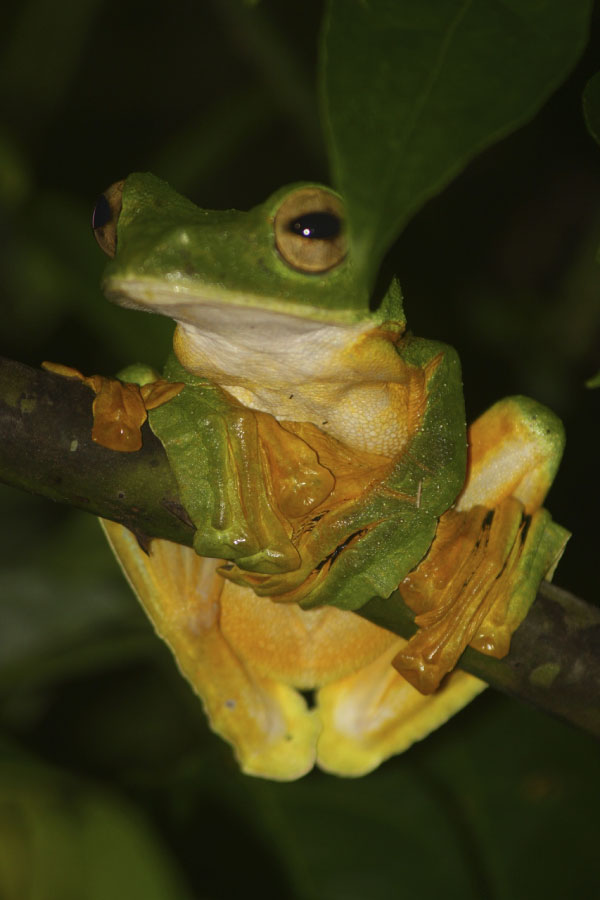
Flying frogs are not true fliers but rather gliders. These amphibians have developed elongated webbed feet that act like wings, allowing them to glide from one tree to another to escape predators or to travel. A flap of skin stretching between their limbs helps them make prolonged leaps. The Wallace’s flying frog is a well-known example, exhibiting this remarkable adaptation.
You can find out more about Wallace's flying frog on this page: Wallace's Flying Frog Facts
Tree Frogs
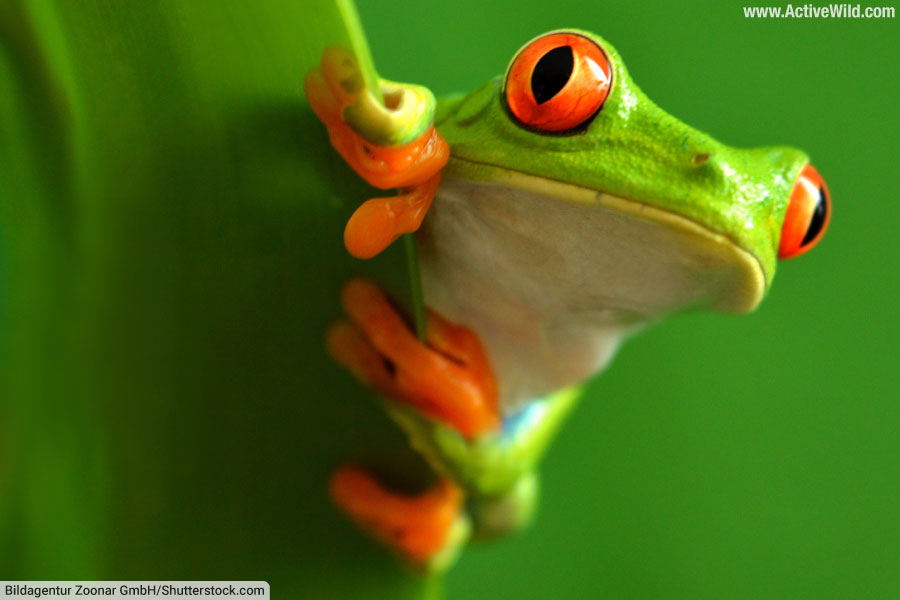
Tree frogs are a diverse group of amphibians that are typically characterized by their ability to climb trees and other vegetation. They have sticky pads on their toes, which aid in gripping smooth surfaces, and many have long legs for powerful jumping.
Tree frogs are found in a variety of environments, from tropical rainforests to temperate woods.
You can find out more about the red-eyed tree frog on this page: Red-Eyed Tree Frog Facts
Arboreal Birds
Although many birds rely on trees for shelter, protection from predators and food, some bird groups are particularly associated with an arboreal lifestyle. Details of three of these are provided below:
Toucans
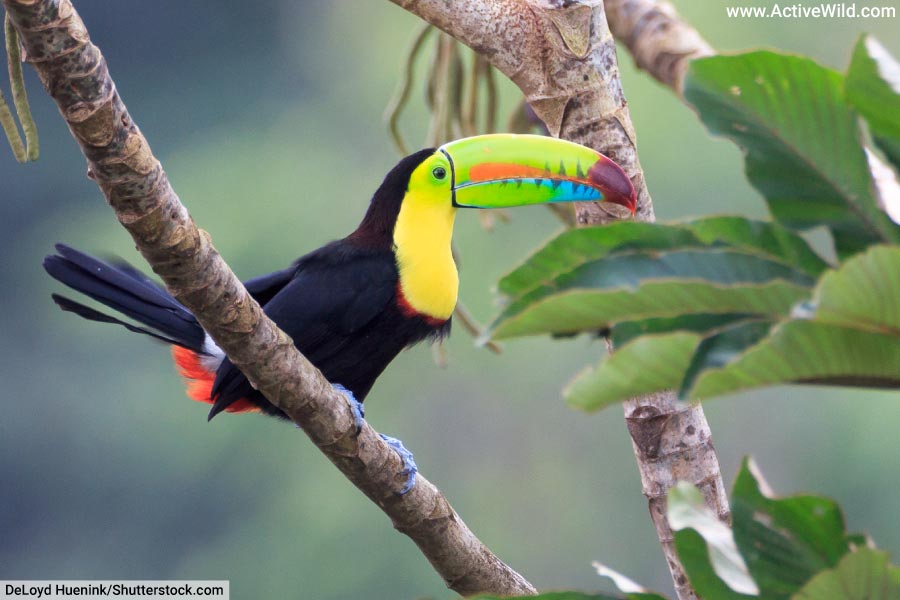
Toucans are a family of birds known for their large, colorful beaks. These tropical birds are found in the rainforests of Central and South America and are predominantly frugivorous, though they will also eat insects and small lizards. Their bright beaks are not just for show; they play a role in mating rituals and are used to peel fruit and deter predators in the tree canopy.
You can find out more about toucans on this page: Toucan Facts
Treecreepers

Treecreepers are small, inconspicuous birds that are members of the family Certhiidae. They have slender, down-curved beaks for extracting insects and spiders from bark crevices. Their stiff tail feathers provide support against tree trunks as they spiral upward, searching for food.
Treecreepers are found in wooded areas across the Northern Hemisphere.
Woodpeckers

Woodpeckers are part of the family Picidae and are known for their strong beaks and shock-absorbent skulls, which allow them to peck at wood to find insects, create nesting cavities, and communicate through drumming.
These arboreal birds have long, barbed tongues to extract food from holes in wood and zygodactyl feet—two toes facing forward and two backward—for excellent grip on tree trunks.
Arboreal Insects
Bark Beetles
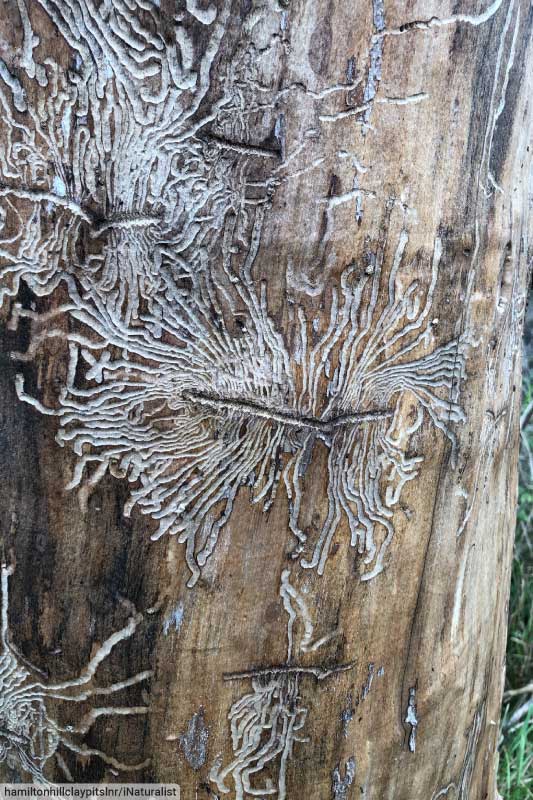
Bark beetles are a group of small, cylindrical insects found worldwide, primarily within the family Curculionidae (subfamily Scolytinae). They bore through and live in the bark of trees, often creating intricate galleries where they lay their eggs.
Some species can be detrimental to forests, as they can carry fungi and diseases, like the Dutch elm disease, contributing to tree mortality.
You can find out more about beetles on this page: Beetle Facts
Tree Crickets

Tree crickets belong to the subfamily Oecanthinae. These arboreal insects are generally pale green or whitish, making them well camouflaged among foliage where they feed on plant material and sometimes on small insects. Many are nocturnal.
Treehoppers

Treehoppers represent a variety of species within the family Membracidae, distinguished by their unique pronotum that often mimics thorns or plant parts, providing camouflage and protection from predators. They feed on plant sap using their piercing mouthparts and can be found in both temperate and tropical habitats.
Some treehopper species engage in mutualistic relationships with ants, which feed on the honeydew produced by treehoppers.
Weaver Ants
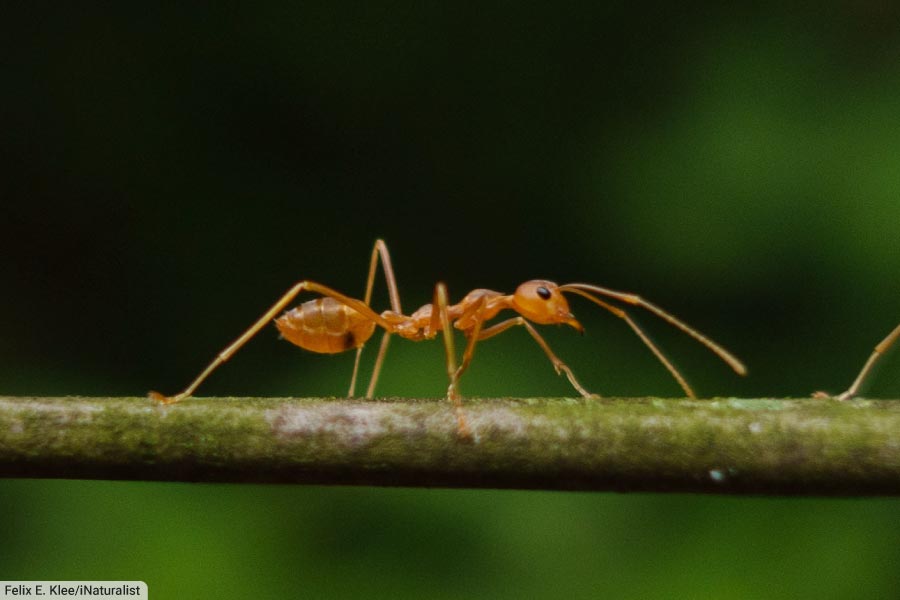
Weaver ants of genus Oecophylla live in trees and are renowned for their unique nest-building behavior, which involves weaving leaves together using silk produced by their larvae.
These highly social and territorial ants are found in tropical Asia and Australasia, and they play a significant role in the ecosystem by controlling pest populations and facilitating the pollination of flowers.
Arboreal Mammals
Gibbons

Gibbons are small to medium-sized apes known for their long arms and incredible ability to brachiate, swinging from branch to branch with agility and speed.
There are 20 species of gibbon (source). Together, they make up the family Hylobatidae, and are also known as the "lesser apes", distinguishing them from the "great apes" of family Hominidae.
Gibbons are native to the rainforests of Southeast, South, and East Asia. They typically form monogamous pair bonds and utilize complex vocalizations to mark their territory.
You can find out more about primates on this page: Primates – Ultimate Guide
Lemurs
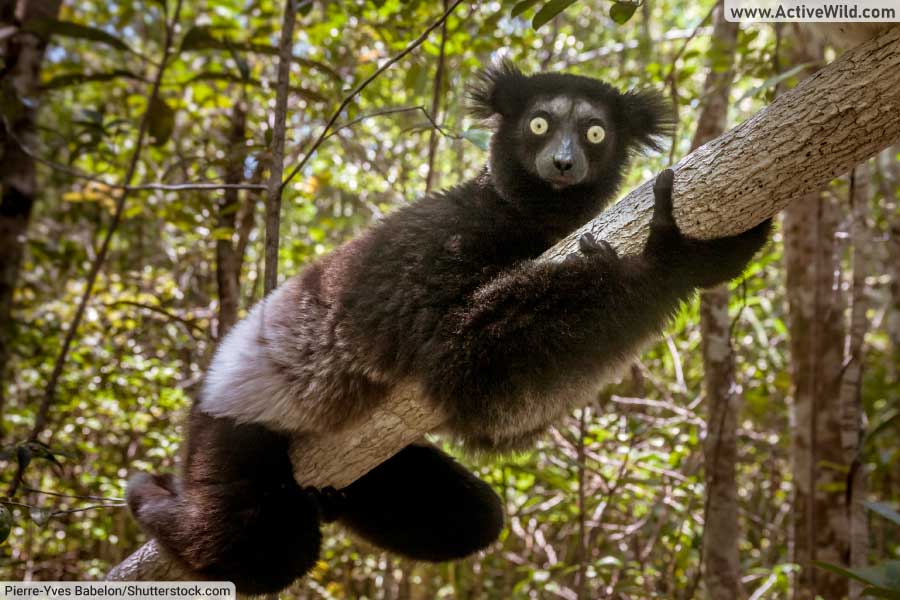
Lemurs are a group of primates unique to the island of Madagascar. They exhibit a wide range of sizes and behaviors, but many are arboreal, living in the trees where they forage for fruit, leaves, and insects.
Many lemurs have large, reflective eyes adapted to nocturnal vision, and some species are highly social, living in large groups.
At the time of writing, The Catalogue of Life lists 106 lemur species (source). Many of these are endangered, due mainly to habitat loss.
You can find out more about primates on this page: Primates – Ultimate Guide
Martens

Martens are slender, agile mammals belonging to the Mustelidae family, the same family that includes weasels and otters.
Tree-dwelling species like the pine marten are adapted to a life in the forest canopy in the Northern Hemisphere, where they hunt small mammals, birds, and insects, and are also known to consume fruits and nuts.
Monkeys

Monkeys are a large and varied group of primates, excluding apes, that are generally characterized by their tails. They are found in both New World (Central and South America) and Old World (Africa and Asia) regions. Many species are arboreal, adept at swinging through trees, although some species are more terrestrial.
You can find out more about monkeys on this page: Monkeys – The Ultimate Guide
Discover different types of monkeys on this page: Types of Monkeys
Orangutans
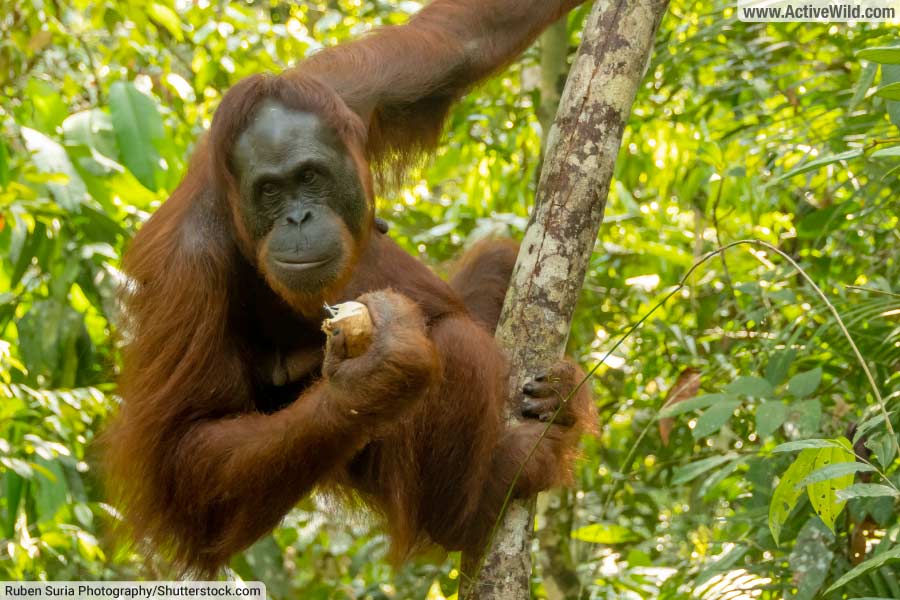
Orangutans inhabit forests on the islands of Borneo and Sumatra, and are the only great apes found in Asia. They are characterized by their reddish-brown hair, long arms, and hook-shaped hands perfect for gripping onto branches.
The three species of orangutan are the most arboreal of all the great apes, and the largest of all arboreal mammals.
Orangutans are highly intelligent and exhibit complex behaviors, including tool use. Orangutans are primarily solitary and have a slow reproductive rate, contributing to their vulnerability to extinction. All three species are rated Critically Endangered.
You can read the story of a young orangutan affected by deforestation in our book, Tales From The Brink
You can find out more about primates on this page: Primates – Ultimate Guide
You can see more critically endangered animals on this page: Critically Endangered Species
Sloths
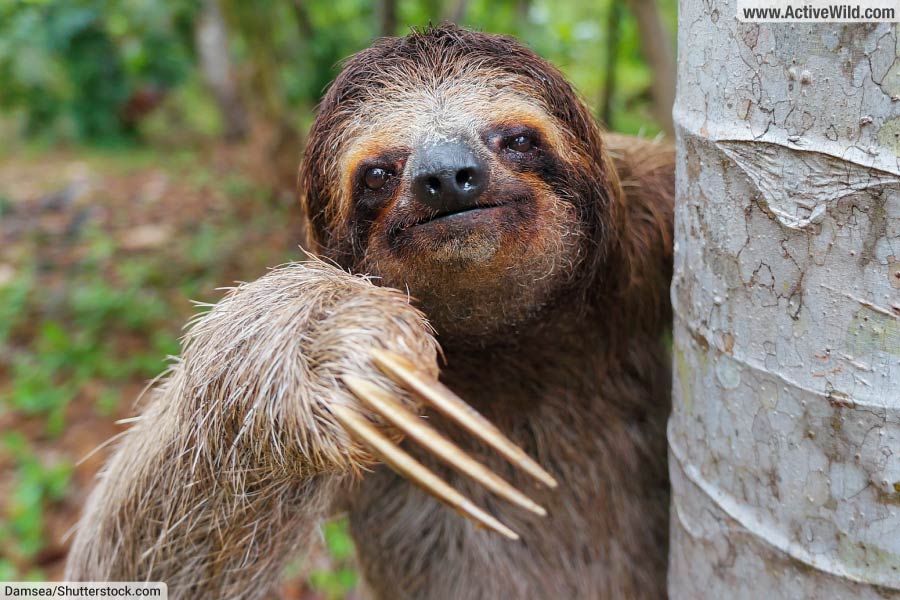
Sloths are medium-sized mammals known for their slow movement, spending most of their lives hanging upside down in the trees of Central and South American rainforests. Their diet mainly consists of leaves and fruit. They have specialized claws for gripping branches and a slow metabolism that conserves energy.
You can see every living sloth species on this page: Types Of Sloths With Pictures And Facts
Squirrels
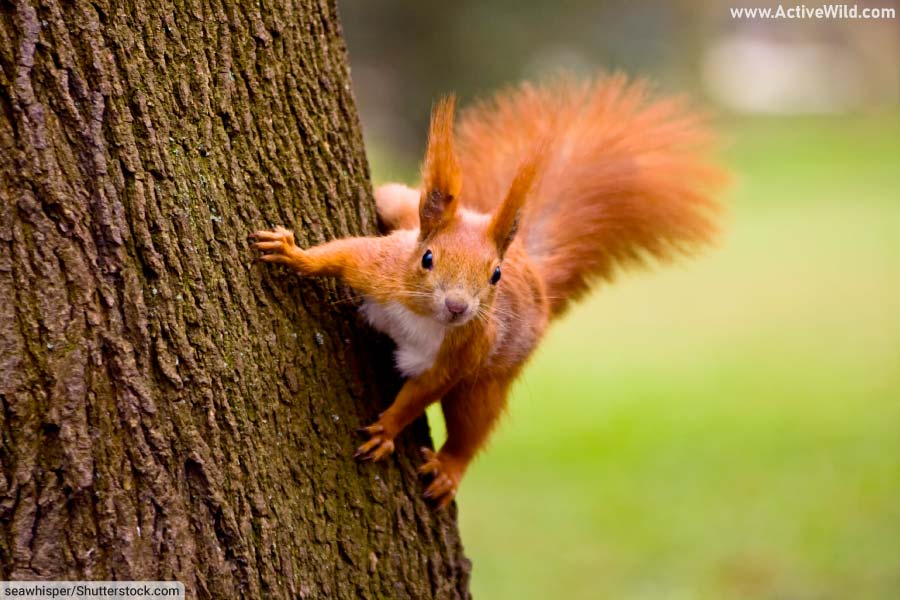
Squirrels are small to medium-sized rodents with a large bushy tail. They are found in nearly every habitat from tropical forests to semiarid desert, avoiding only the high polar regions and very dry deserts. While many species are adept at climbing and live in trees, others are ground-dwelling.
Tree Kangaroos

Tree kangaroos are marsupials of the genus Dendrolagus, adapted for an arboreal lifestyle in the rainforests of Australia, West Papua, and Papua New Guinea.
Unlike their ground-dwelling relatives, tree kangaroos have strong forelimbs for climbing, a broader diet that includes a variety of plant materials, and they are skilled at leaping from branch to branch.
Arboreal Reptiles
Chameleons
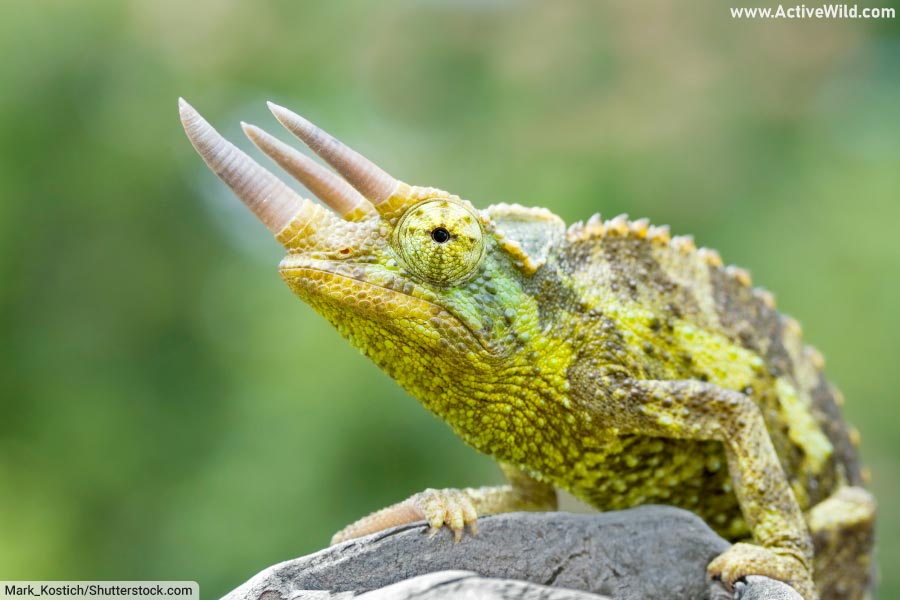
Chameleons are a distinctive and highly specialized clade of lizards known for their ability to change color, their independently mobile eyes, and their long, projectile tongues used to capture insects.
The arboreal reptiles have zygodactylous feet—two toes pointing forward and two backward—for gripping branches, and many species have a prehensile tail for added stability in their mostly arboreal habitat.
Discover different types of lizards on this page: Types of Lizards
Flying Snakes
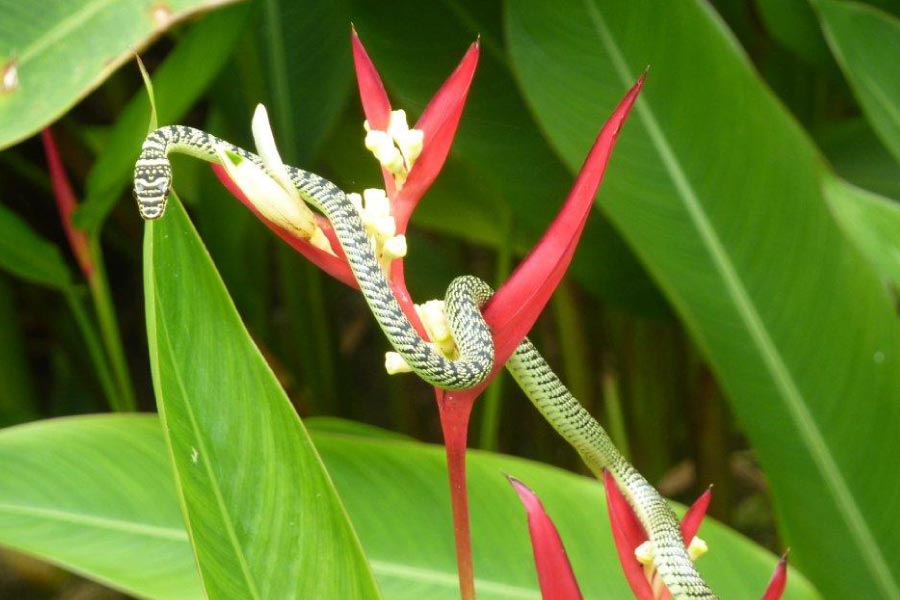
Flying snakes are a group of snakes from the genus Chrysopelea found in Southeast Asia that have the remarkable ability to glide in the air. They achieve this by flattening their bodies to create lift and can make controlled aerial descents from tree to tree or from tree to ground.
Despite their name, flying snakes do not actually fly but rather glide through the air.
You can find out more about snakes on this page: Snake Facts
Discover different types of snakes on this page: Types of Snakes
Geckos
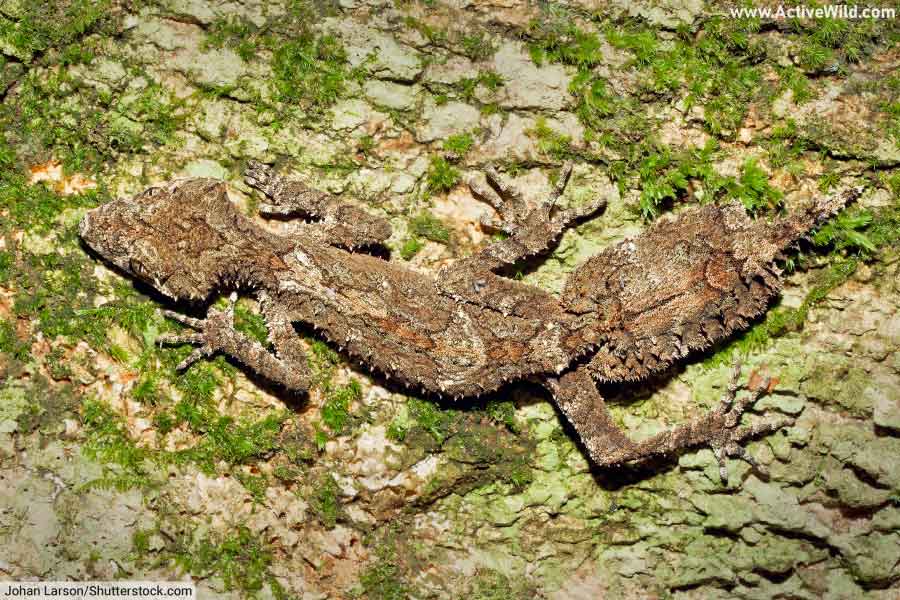
Geckos are small to medium-sized, mostly arboreal, lizards known for their remarkable adhesive toe pads that increase friction and allow them to climb smooth and vertical surfaces, including glass.
These toe pads, which are found in many, but not all, gecko species, have tiny hair-like structures that exploit molecular adhesion forces between their feet and the surface on which they are climbing (source).
Geckos are found in warm climates throughout the world and display a variety of colors and patterns. They are unique among lizards in their vocalizations, which they use for social interaction.
Discover different types of lizards on this page: Types of Lizards
List Of Arboreal Species
Acorn Woodpecker

- Scientific Name: Melanerpes formicivorus
- Order: Piciformes
- Family: Picidae
- Where found: Western North America, from Oregon to Colombia and parts of Central America.
- IUCN conservation status: Least Concern
The Acorn Woodpecker is known for storing acorns in large communal granaries, usually by drilling holes in trees or wooden structures to wedge the acorns in. They have a black body, a striking red cap, and a clown-like face.
Discover different types of birds on this page: Types of Birds
Arboreal Salamander

- Scientific Name: Aneides lugubris
- Order: Caudata
- Family: Plethodontidae
- Where found: California and Baja California, Mexico
- IUCN conservation status: Least Concern
The Arboreal Salamander is a lungless salamander that breathes through its skin and the lining of its mouth. It is a good climber, with a prehensile tail, and is often found in oak woodlands and mixed forests.
Arboreal salamanders are found in woodlands and chaparral in California, USA, and Baja California, Mexico.
You can find out more about amphibians on this page: Amphibians - The Ultimate Guide
You can discover more amphibians on this page: Amphibians Examples
Aye-Aye
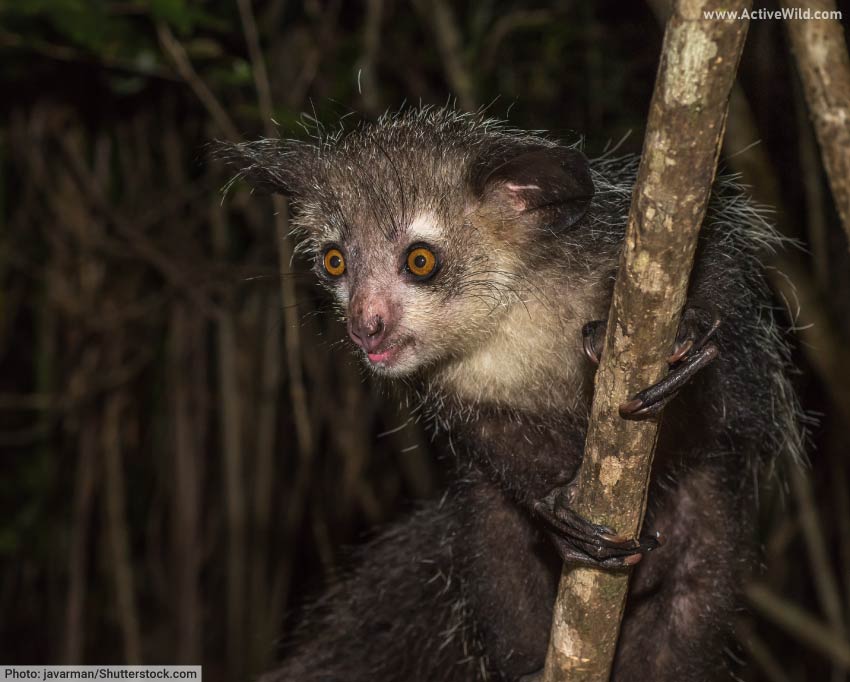
- Scientific Name: Daubentonia madagascariensis
- Order: Primates
- Family: Daubentoniidae
- Where found: Native to Madagascar
- IUCN conservation status: Endangered
The Aye-Aye is a nocturnal and arboreal lemur known for its distinctive method of finding food: it taps on trees to find grubs, then gnaws holes in the wood and extracts them with its long middle finger.
You can find out more about the aye-aye on this page: Aye-Aye Facts
Black Howler Monkey
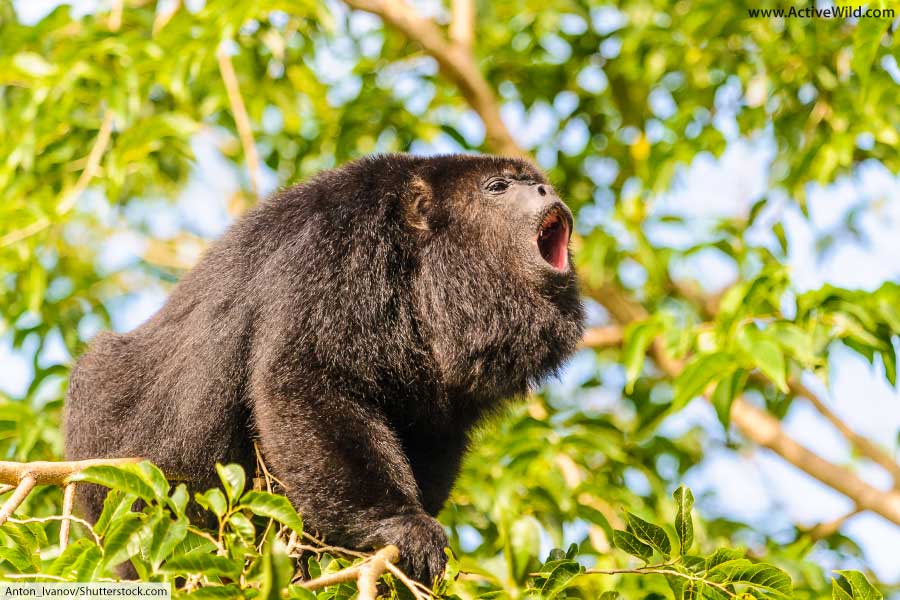
- Scientific Name: Alouatta caraya
- Order: Primates
- Family: Atelidae
- Where found: Forests and woodlands of eastern Bolivia, northern Argentina, Paraguay, and Brazil.
- IUCN conservation status: Near Threatened
The black howler monkey, also known as the black and gold howler monkey, is a species of New World monkey recognized by the black fur of the males, and the golden-brown fur of the females and infants.
Howler monkeys make up the genus Alouatta, part of the family Atelidae, which is also home to spider monkeys, woolly monkeys, and woolly spider monkeys. They are named after their loud howl-like calls, which can be heard over considerable distances.
You can find out more about howler monkeys on this page: Howler Monkey Facts
Geoffroy’s Spider Monkey
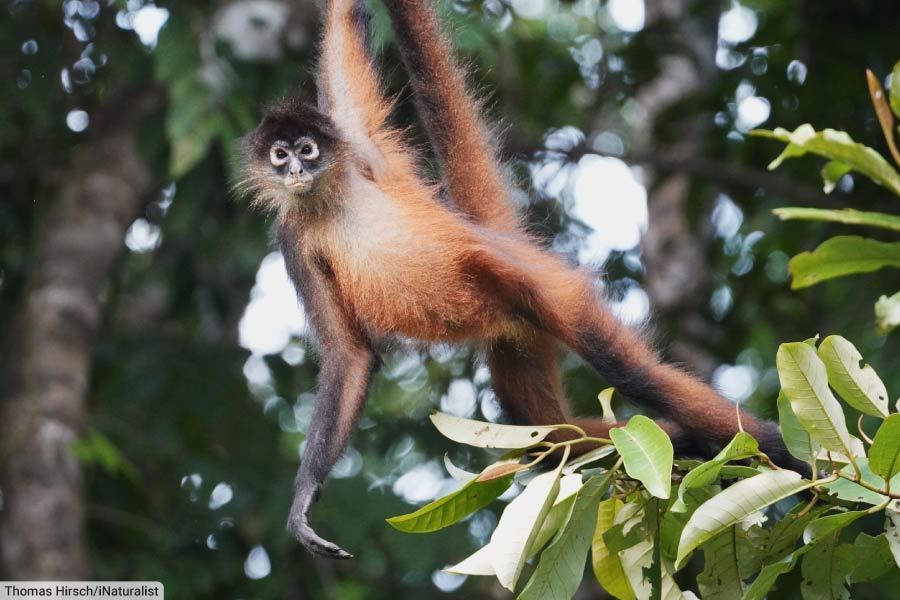
- Scientific Name: Ateles geoffroyi
- Order: Primates
- Family: Atelidae
- Where found: Throughout Central America and into parts of Mexico and Colombia
- IUCN conservation status: Endangered
Geoffroy’s Spider Monkey is also known as the Central American Spider Monkey or the black-handed spider monkey. Like all spider monkeys, it has long, spider-like limbs and a long, prehensile tail, which it uses as a fifth limb to swing from branch to branch.
This arboreal species has a highly frugivorous diet, though it also eats leaves and flowers. Its social structure is complex and fission-fusion, meaning group size and composition can change throughout the day.
You can find out more about spider monkeys on this page: Spider Monkey Facts
Crested Gecko

- Scientific Name: Correlophus ciliatus
- Order: Squamata
- Family: Diplodactylidae
- Where found: New Caledonia
- IUCN conservation status: Vulnerable
The Crested Gecko is known for the hair-like projections above its eyes, resembling eyelashes, and a crest that runs from each eye to the tail.
This arboreal species has toe pads that allows it to climb smooth surfaces, and is a popular pet due to its docile nature and ease of care.
Discover different types of lizards on this page: Types of Lizards
Eastern Green Mamba

- Scientific Name: Dendroaspis angusticeps
- Order: Squamata
- Family: Elapidae
- Where found: East African coastal region, from Kenya to South Africa
- IUCN conservation status: Least Concern
The Eastern Green Mamba is a highly venomous snake, slender, and agile, predominantly arboreal, and it has a bright green coloration which provides excellent camouflage in its forested habitats. It feeds on birds and small mammals.
You can find out more about snakes on this page: Snake Facts
Discover different types of snakes on this page: Types of Snakes
Emerald Tree Boa

- Scientific Name: Corallus caninus
- Order: Squamata
- Family: Boidae
- Where found: Rainforests in South America, primarily the Amazon basin
- IUCN conservation status: Least Concern
The Emerald Tree Boa is known for its striking green color with white markings along its body. It spends most of its life in the canopy and is nocturnal, feeding on small mammals and occasionally birds.
You can find out more about snakes on this page: Snake Facts
Discover different types of snakes on this page: Types of Snakes
Florida Tree Snail

- Scientific Name: Liguus fasciatus
- Order: Stylommatophora
- Family: Orthalicidae
- Where found: Florida, particularly in the Everglades and the Florida Keys
- IUCN conservation status: Not Listed
The Florida Tree Snail is known for its colorful and patterned shell. These striking mollusks are arboreal, living on trees where they feed on lichens and fungi. Their coloration and pattern are highly variable, depending on their specific habitat.
Discover different types of mollusks on this page: Mollusks Examples
Gray Squirrel

- Scientific Name: Sciurus carolinensis
- Order: Rodentia
- Family: Sciuridae
- Where found: Eastern and Midwestern United States, and into parts of Canada; introduced to the United Kingdom, Ireland, and South Africa
- IUCN conservation status: Least Concern
The Gray Squirrel is a tree-dwelling rodent known for its bushy tail and for storing nuts for the winter. It has predominantly grey fur, but it can have a brownish color. It is very adaptable and is considered a significant agricultural pest in some regions.
Discover different types of mammals on this page: Types of Mammals
Green Iguana
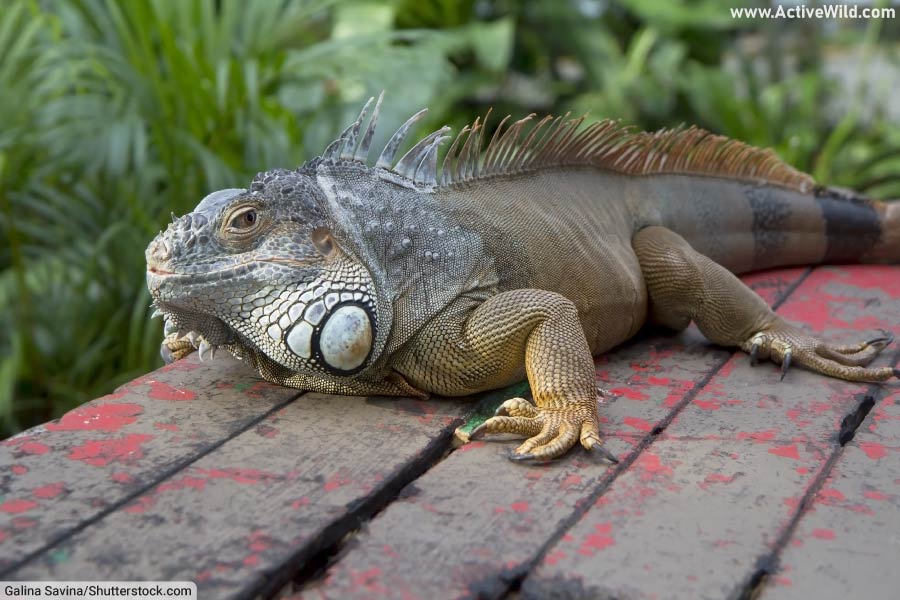
- Scientific Name: Iguana iguana
- Order: Squamata
- Family: Iguanidae
- Where found: Central and South America, and some Caribbean islands
- IUCN conservation status: Least Concern
The Green Iguana is a large, arboreal lizard often found near water. It is mainly herbivorous, feeding on leaves, flowers, and fruit.
The species is known for its striking green color, spiny back, and long tail, which is used as a whip for defense.
You can find out more about this species on this page: Iguana Facts
Keel-Billed Toucan

- Scientific Name: Ramphastos sulfuratus
- Order: Piciformes
- Family: Ramphastidae
- Where found: From Southern Mexico to Venezuela and Colombia
- IUCN conservation status: Near Threatened
The Keel-Billed Toucan is noted for its colorful bill, which is one of the most vivid of any bird in the world. It's a social bird, often seen in small flocks in a variety of forested habitats. It eats a diet mostly of fruit but will also take insects, lizards, and eggs.
You can find out more about toucans on this page: Toucan Facts
Kinkajou
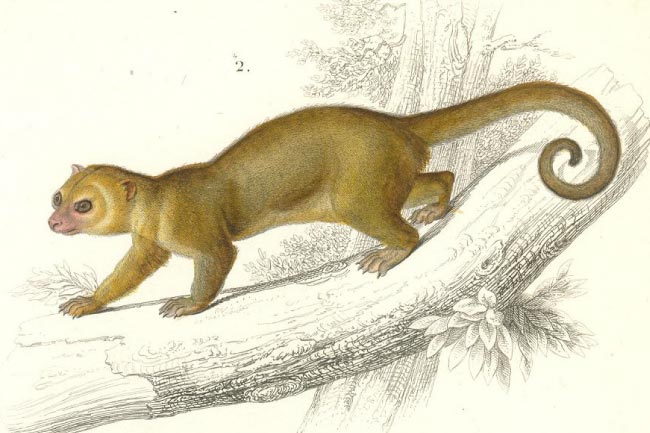
- Scientific Name: Potos flavus
- Order: Carnivora
- Family: Procyonidae
- Where found: From southern Mexico through Brazil and Bolivia
- IUCN conservation status: Least Concern
The Kinkajou is a nocturnal, tree-dwelling mammal with a prehensile tail, allowing it to grasp branches as it moves through the forest canopy. It has a bear-like face and is sometimes called a "honey bear." Kinkajous are frugivorous but also eat flowers and occasionally small vertebrates.
You can see more rainforest animals on this page: Rainforest Animals List with Pictures & Facts
Koala

- Scientific Name: Phascolarctos cinereus
- Order: Diprotodontia
- Family: Phascolarctidae
- Where found: Eastern Australia
- IUCN conservation status: Vulnerable
The Koala is an iconic Australian marsupial, living almost exclusively on eucalypt leaves. It has a stout, tailless body, a large head with round, fluffy ears, and a spoon-shaped nose.
Koalas are well-adapted to their arboreal lifestyle, with strong limbs and opposable digits for gripping branches.
You can find out more about koalas on this page: Koala Facts
You can see more Australian animals on this page: Australian Animals
Lar Gibbon
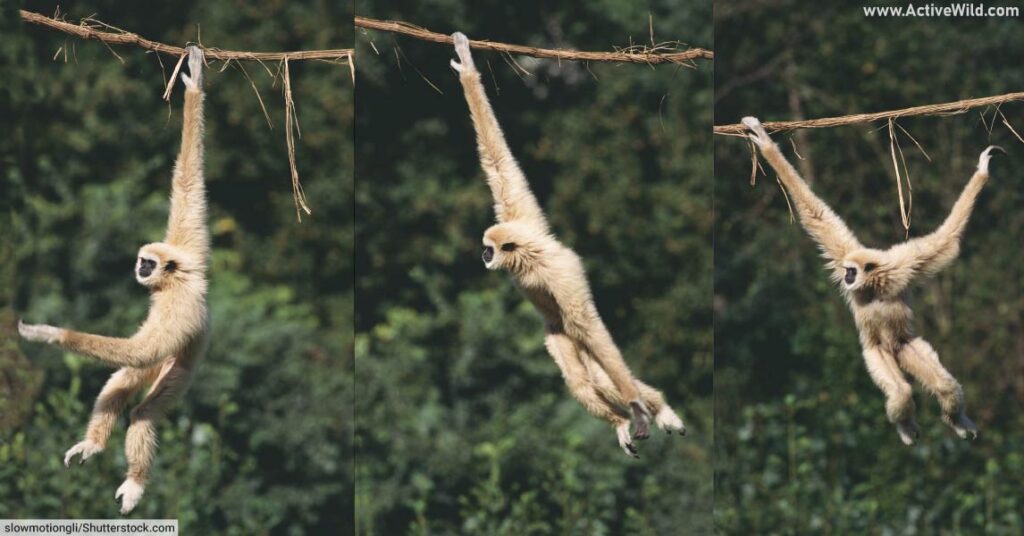
- Scientific Name: Hylobates lar
- Order: Primates
- Family: Hylobatidae
- Where found: Southeast Asian forests, including Indonesia, Laos, Malaysia, Myanmar, and Thailand
- IUCN conservation status: Endangered
The Lar Gibbon, also known as the white-handed gibbon, is a small arboreal ape known for its agility and ability to brachiate through the trees. It has a varied diet of fruit, leaves, and sometimes insects.
Socially, Lar gibbons are monogamous and territorial, often heard singing in the morning to establish territory and communicate with their mate.
You can see more Asian animals on this page: Asian Animals
Margay
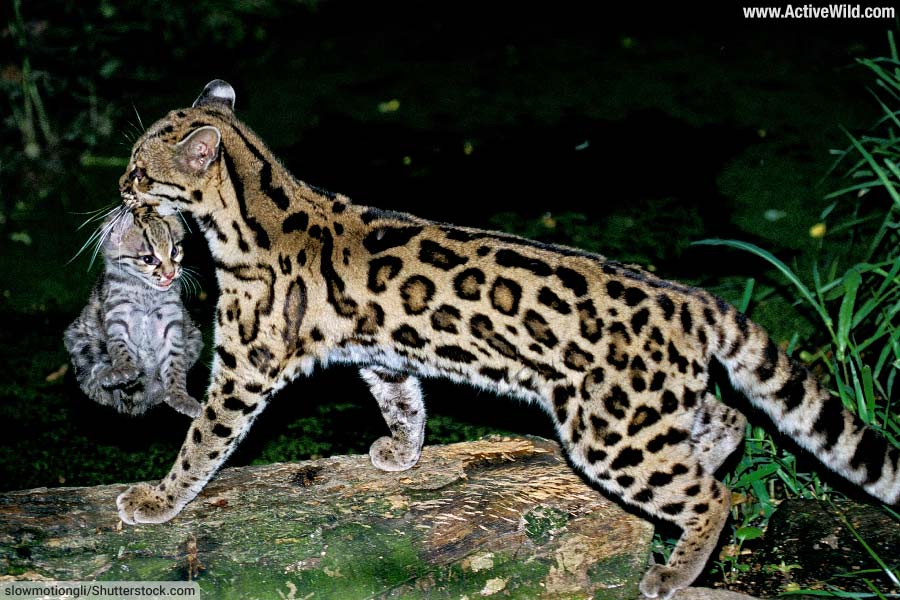
- Scientific Name: Leopardus wiedii
- Order: Carnivora
- Family: Felidae
- Where found: Forested regions from Mexico, through Central America, to South America
- IUCN conservation status: Near Threatened
The Margay is a small wild cat with a spotted coat, similar in appearance to the ocelot. The species is highly adapted to an arboreal lifestyle, with flexible ankle joints that can rotate 180 degrees, enabling it to climb down trees head-first.
It primarily hunts at night for small mammals, birds, and reptiles.
Find out more about the margay on this page: Margay Facts
You can see EVERY species of cat on this page: Wild Cats Species List with Pictures and Facts
Northern Green Tree Python

- Scientific Name: Morelia viridis
- Order: Squamata
- Family: Pythonidae
- Where found: Rainforests of New Guinea, islands in Indonesia, and Cape York Peninsula in Australia
- IUCN conservation status: Least Concern
The Northern Green Tree Python is known for its striking green coloration which provides camouflage in the foliage. It exhibits arboreal behavior, often seen in a characteristic coiled position over branches. It preys on small mammals and sometimes birds, capturing them with a quick strike and constriction.
You can find out more about snakes on this page: Snake Facts
Discover different types of snakes on this page: Types of Snakes
Silky Anteater

- Scientific Name: Cyclopes didactylus
- Order: Pilosa
- Family: Cyclopedidae
- Where found: Tropical rainforests in Central and South America
- IUCN conservation status: Least Concern
The Silky Anteater is one of the smallest anteater species, with fine silky fur, ranging in color from gray to golden brown. It is nocturnal and arboreal, spending most of its life in the treetops and feeding primarily on ants.
Like many arboreal animals, the silky anteater has a prehensile tail, aiding in climbing and balance.
You can find out more about anteaters on this page: Anteater Facts
Southern Flying Squirrel
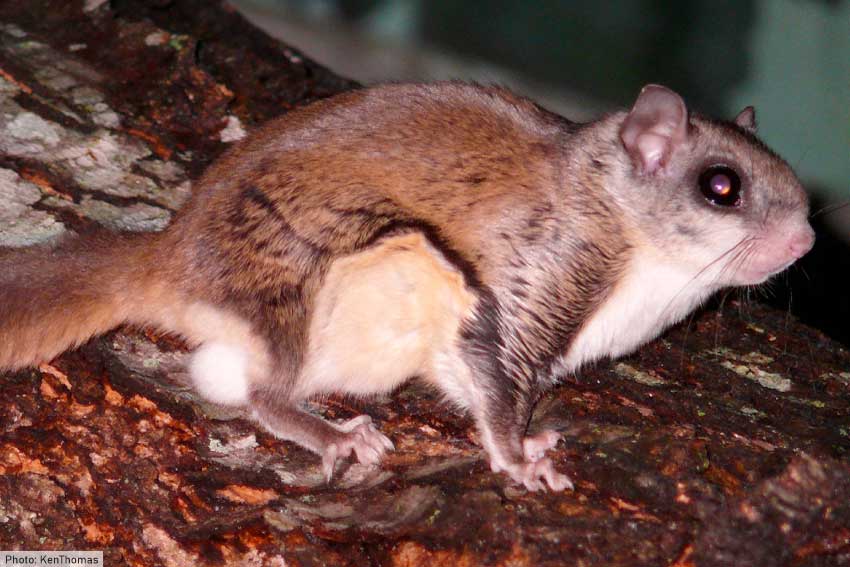
- Scientific Name: Glaucomys volans
- Order: Rodentia
- Family: Sciuridae
- Where found: Eastern North America
- IUCN conservation status: Least Concern
The Southern Flying Squirrel is known for its nocturnal habits and its ability to glide between trees using a patagium, a membrane stretching between its limbs. It has large eyes, a flattened tail, and feeds on nuts, seeds, insects, and sometimes fungi or bird eggs.
You can find out more about flying squirrels on this page: Flying Squirrel Facts
Sugar Glider

- Scientific Name: Petaurus breviceps
- Order: Diprotodontia
- Family: Petauridae
- Where found: Native to eastern and northern mainland Australia, New Guinea, and certain islands of Indonesia
- IUCN conservation status: Least Concern
The Sugar Glider is a small, omnivorous, arboreal, and nocturnal gliding possum with a similar membrane to the flying squirrel for gliding. It has a squirrel-like body with a long, partially prehensile tail. It feeds on sap, nectar, pollen, and insects.
You can find out more about sugar gliders on this page: Sugar Glider Facts
Sun Bear
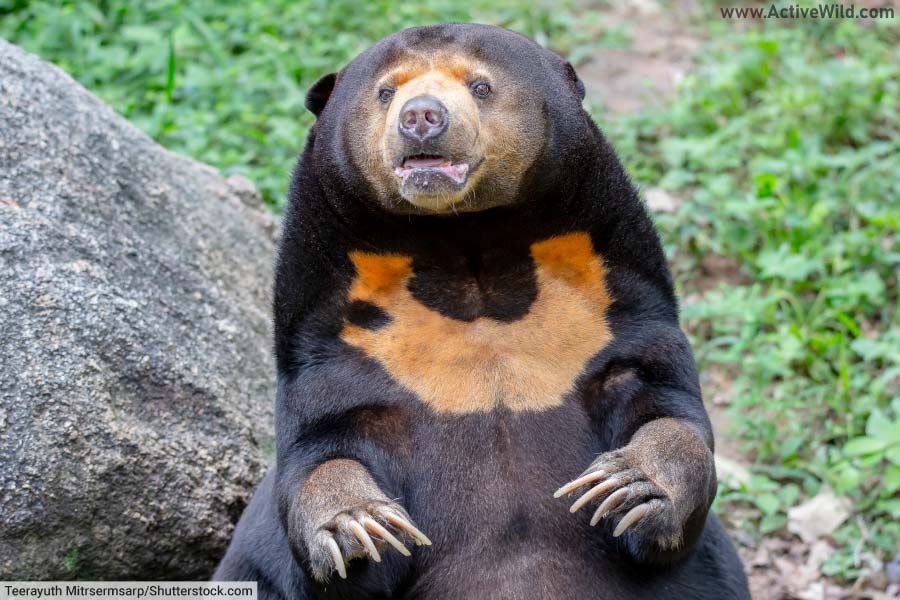
- Scientific Name: Helarctos malayanus
- Order: Carnivora
- Family: Ursidae
- Where found: Tropical forest habitats in Southeast Asia
- IUCN conservation status: Vulnerable
The Sun Bear is the smallest member of the bear family and the most arboreal. It is characterized by its sleek, dark fur with a distinctive orange to cream colored chest patch. Its strong forelimbs, large paws and long claws are adaptations for climbing trees.
Sun Bears are omnivorous, feeding on insects, honey, fruit, and occasionally small vertebrates.
You can find out more about sun bears on this page: Sun Bear Facts
Verreaux’s Sifaka
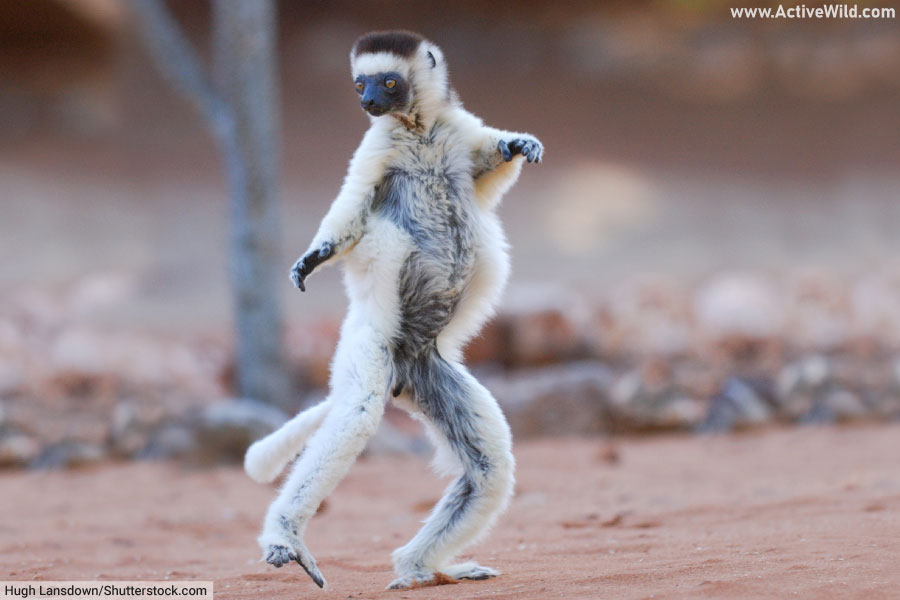
- Scientific Name: Propithecus verreauxi
- Order: Primates
- Family: Indriidae
- Where found: Madagascar
- IUCN conservation status: Critically Endangered
Verreaux's Sifaka is a medium-sized lemur with long, powerful hind limbs for leaping through trees. It has a creamy white coat with patches of dark fur on the sides and top of its head.
It is diurnal and folivorous, primarily eating leaves, though it will also consume fruit and flowers.
You can find out more about primates on this page: Primates – Ultimate Guide
White-Lipped Tree Frog
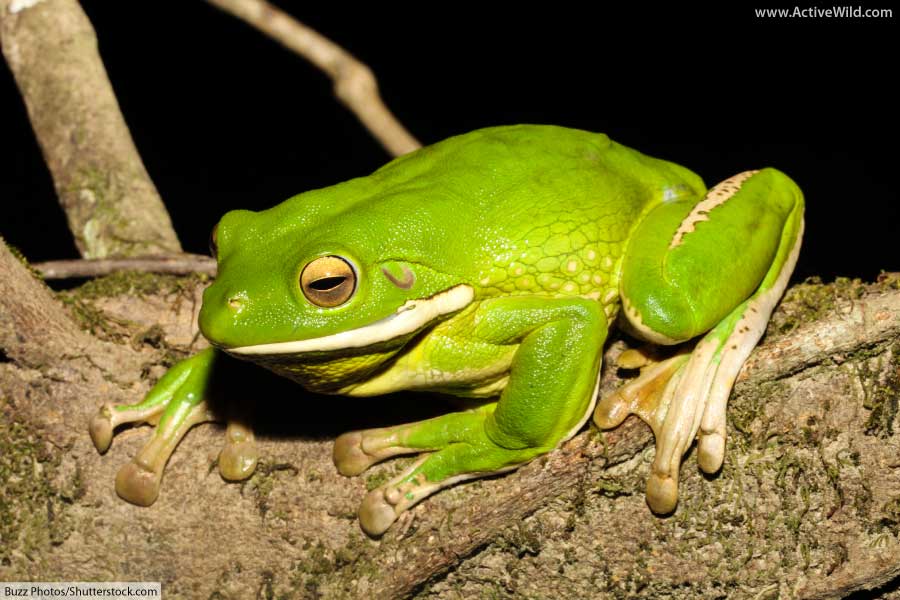
- Scientific Name: Litoria infrafrenata
- Order: Anura
- Family: Hylidae
- Where found: New Guinea and northern Australia
- IUCN conservation status: Least Concern
The White-Lipped Tree Frog is one of the largest tree frog species, with a vibrant green color and a conspicuous white stripe on its lower lip. It is arboreal and nocturnal, typically found in rainforest habitats and often near human dwellings. Its diet consists mainly of insects and other invertebrates.
Discover more Australian amphibians on this page: Australian Amphibians
Discover More With Active Wild
Visit our main animals page for links to animal information and a complete guide to the animal kingdom: Animals
You can see more forest animals on this page: Forest Animals
You can see more rainforest animals on this page: Rainforest Animals List with Pictures & Facts

